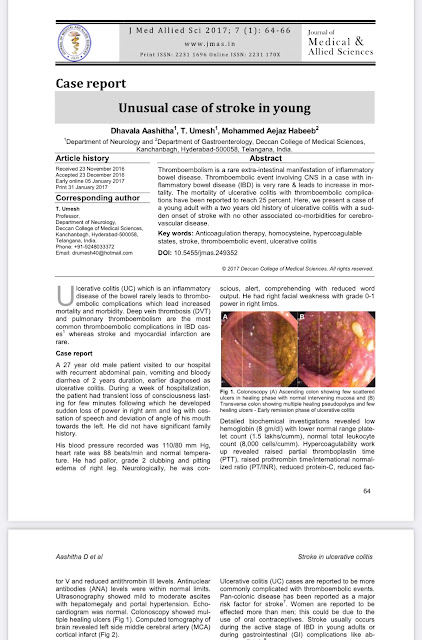The different medical complications observed in a rural medical hospital from excessive alcohol indulgence and the importance of alcohol abstinence
The different medical complications observed in a rural medical hospital from excessive alcohol indulgence and the importance of alcohol abstinence
Abstract:
Introduction:
Alcohol consumption has been identified as an important risk factor for illness, disability, and mortality (Rehm et al. 2009b).
In this study we discuss the various medical conditions we've come across at a rural medical hospital caused by alcohol and conditions where in alcohol plays a role of a contributing factor and the importance of alcohol abstinence.
Materials and methods:
This is a prospective study conducted at Kamineni Insitute of Medical Scineces, Narketpally including 70 inpatients after taking their informed consent.
Results:
The most common disease categories observed during this study entirely or partly caused by alcohol consumption were liver and pancreatic diseases (49%), neuropsychiatric diseases ( 31%), cardiovascular diseases(13%), diabetes (4%), 3% presenting with multiorgan dysfunction syndrome after binge consumption of alcohol.
Discussion:
Most of the burden associated with alcohol use stems from regular heavier drinking, defined, for instance, as drinking more than 40 grams of pure alcohol per day for men and 20 grams of pure alcohol per day for women (Patra et al. 2009; Rehm et al. 2004). In addition to the average volume of alcohol consumption, patterns of drinking—especially irregular heavy-drinking or binge drinking (defined as drinking atleast 60 grams of pure alcohol or five standard drinks in one sitting)—markedly contribute to the associated burden of disease and injury (Gmel et al. 2010; Rehm et al.)
Conclusion:
Our study highlights alcohol’s impact on the burden of disease as well as on other social, legal, and financial factors, and the need for effective interventions that could prevent the initiation of drinking particularly among adolescents, and limit among those who do consume alcohol.
As they say, first you take a drink, then a drink takes a drink, then the drink takes you.
References:
Rehm J, Parry C. Alcohol consumption and infectious diseases in South Africa. Lancet. 2009;374(9707):2053.
Patra J, Taylor B, Rehm J. Deaths associated with high-volume drinking of alcohol among adults in Canada in 2002: A need for primary care intervention? Contemporary Drug Problems. 2009;36(2):283–301.
Rehm J, Room R, Monteiro M, et al. Comparative Quantification of Health Risks: Global and Regional Burden of Disease Attributable to Selected Major Risk Factors. Geneva, Switzerland: World Health Organization; 2004. Alcohol use; pp. 959–1109
Gmel G, Kuntsche E, Rehm J. Risky single occasion drinking: Bingeing is not bingeing. Addiction. 2010 Oct. doi: 10.1111/j.1360-0443.2010.0316710.1111/j.1360-0443.2010.03167.
Abstract:
Introduction:
Alcohol consumption has been identified as an important risk factor for illness, disability, and mortality (Rehm et al. 2009b).
In this study we discuss the various medical conditions we've come across at a rural medical hospital caused by alcohol and conditions where in alcohol plays a role of a contributing factor and the importance of alcohol abstinence.
Materials and methods:
This is a prospective study conducted at Kamineni Insitute of Medical Scineces, Narketpally including 70 inpatients after taking their informed consent.
Results:
The most common disease categories observed during this study entirely or partly caused by alcohol consumption were liver and pancreatic diseases (49%), neuropsychiatric diseases ( 31%), cardiovascular diseases(13%), diabetes (4%), 3% presenting with multiorgan dysfunction syndrome after binge consumption of alcohol.
Discussion:
Most of the burden associated with alcohol use stems from regular heavier drinking, defined, for instance, as drinking more than 40 grams of pure alcohol per day for men and 20 grams of pure alcohol per day for women (Patra et al. 2009; Rehm et al. 2004). In addition to the average volume of alcohol consumption, patterns of drinking—especially irregular heavy-drinking or binge drinking (defined as drinking atleast 60 grams of pure alcohol or five standard drinks in one sitting)—markedly contribute to the associated burden of disease and injury (Gmel et al. 2010; Rehm et al.)
Conclusion:
Our study highlights alcohol’s impact on the burden of disease as well as on other social, legal, and financial factors, and the need for effective interventions that could prevent the initiation of drinking particularly among adolescents, and limit among those who do consume alcohol.
As they say, first you take a drink, then a drink takes a drink, then the drink takes you.
References:
Rehm J, Parry C. Alcohol consumption and infectious diseases in South Africa. Lancet. 2009;374(9707):2053.
Patra J, Taylor B, Rehm J. Deaths associated with high-volume drinking of alcohol among adults in Canada in 2002: A need for primary care intervention? Contemporary Drug Problems. 2009;36(2):283–301.
Rehm J, Room R, Monteiro M, et al. Comparative Quantification of Health Risks: Global and Regional Burden of Disease Attributable to Selected Major Risk Factors. Geneva, Switzerland: World Health Organization; 2004. Alcohol use; pp. 959–1109
Gmel G, Kuntsche E, Rehm J. Risky single occasion drinking: Bingeing is not bingeing. Addiction. 2010 Oct. doi: 10.1111/j.1360-0443.2010.0316710.1111/j.1360-0443.2010.03167.



Comments
Post a Comment